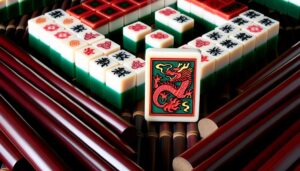Hidden Meaning of Devil in Ohio Symbols?
In 'Devil in Ohio,' symbols such as the pentagram, black rose, and various animal totems are intricately woven into the storyline to serve multiple layers of meaning. The pentagram historically represents protection and balance but is portrayed as sinister in the series.
Black roses underscore themes of mystery and dark beauty, while animal totems reflect characters' struggles and narrative foresight. Sacred geometry and occult symbols deepen the show's enigmatic atmosphere, linking the narrative to profound cultural and spiritual concepts.
Blood rituals evoke connections to divine powers and ancient sacrifices. Each element enhances the haunting thematic depth of the series.
For further exploration, consider the symbolic layers embedded within these motifs.
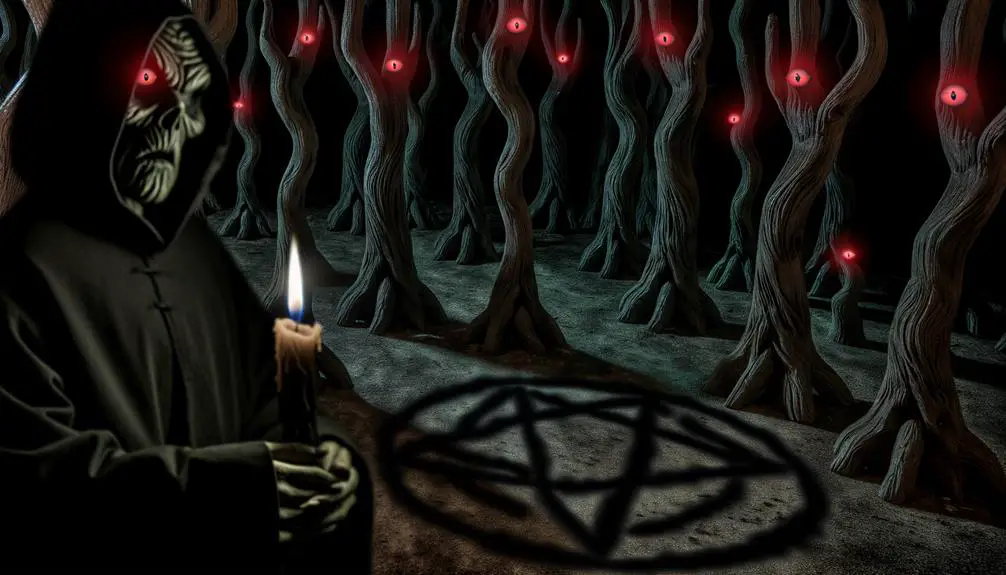
Key Takeaways
- The pentagram symbolizes protection, balance, and is often portrayed as sinister in popular media.
- Animal totems reflect characters' struggles and offer insights into cultural and spiritual beliefs.
- The black rose represents beauty, darkness, and the tension between life and death.
- Sacred geometry, like the Flower of Life, signifies the universe's intrinsic order.
- Ritualistic blood symbolism connects the physical and spiritual domains, representing vitality and sacrifice.
The Pentagram's Power
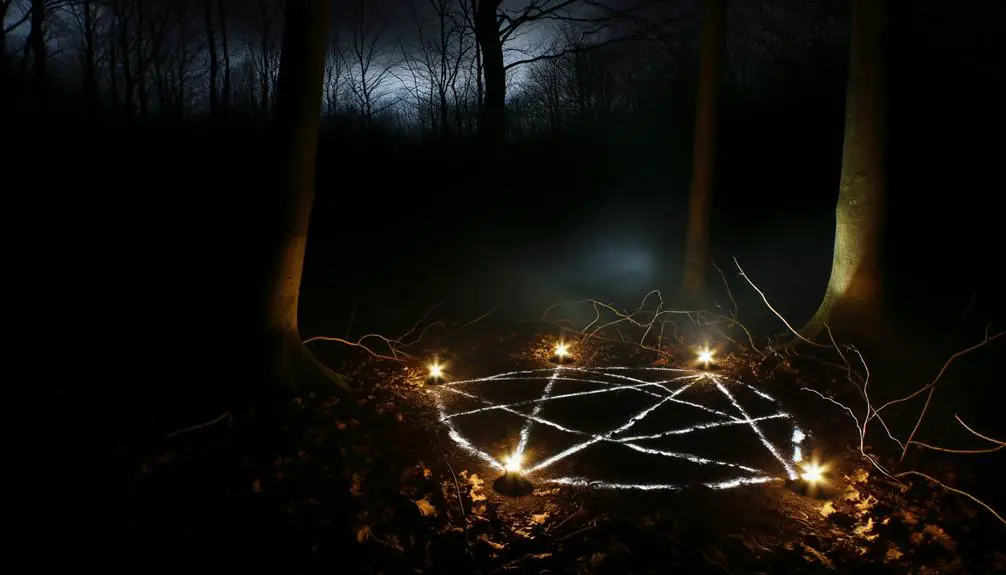
The pentagram, often misunderstood and frequently misrepresented, holds significant symbolic power within various cultural and religious contexts.
Historically, the pentagram has been a symbol of protection and balance. In ancient Greece, it represented the five elements: earth, water, fire, air, and spirit. Early Christians used it to symbolize the five wounds of Christ.
In modern times, the pentagram is commonly associated with neopagan beliefs, particularly Wicca, where it signifies the interconnectedness of all things. However, its depiction in popular media often skews towards the sinister, overshadowing its rich and diverse historical significance.
Understanding the pentagram requires a nuanced approach that acknowledges its multifaceted roles across different traditions and eras, rather than succumbing to contemporary misinterpretations.
Mysterious Animal Totems
Animal totems, shrouded in mystery and steeped in symbolism, offer rich insights into various cultural and spiritual beliefs. In the context of 'Devil in Ohio', these totems serve as potent symbols that convey deeper meanings and connections to the supernatural.
Historically, different animals have been ascribed various traits and spiritual significance, ranging from protection to transformation. The presence of animal totems in the narrative often reflects characters' inner struggles or foretells events, enriching the story's symbolic landscape.
The Black Rose
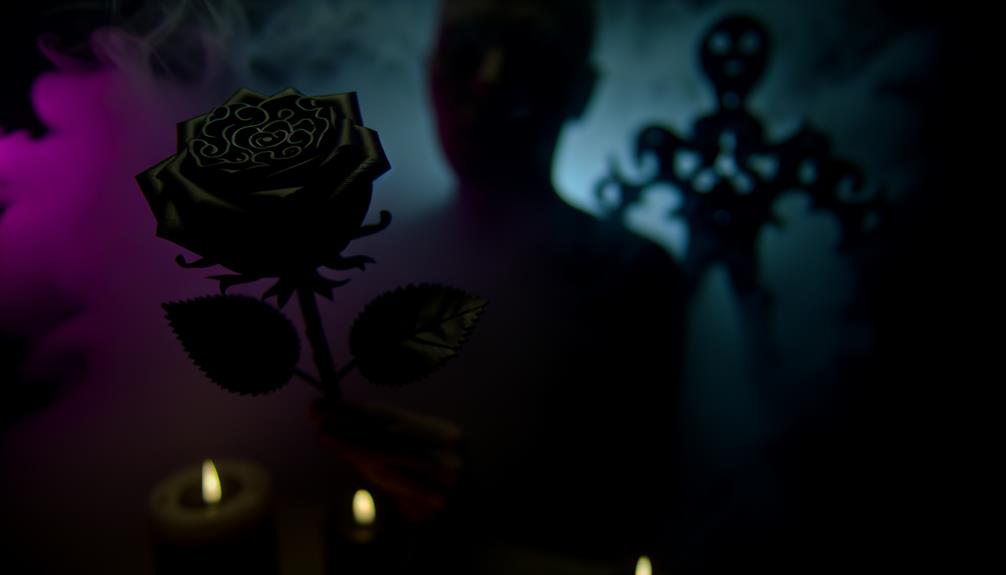
Symbolizing both beauty and darkness, the black rose in 'Devil in Ohio' serves as a multifaceted emblem that intertwines themes of mystery, mortality, and forbidden knowledge. This enigmatic flower represents the duality of human nature, embodying both allure and peril.
Within the narrative, the black rose frequently appears in pivotal moments, underscoring the tension between life and death, innocence and corruption. Its presence suggests an underlying hidden truth or secret that characters must confront.
Moreover, the black rose's association with forbidden knowledge highlights the dangers of delving into unknown territories. By using this symbol, 'Devil in Ohio' effectively captures the intricate interplay between beauty and darkness, adding depth and complexity to its thematic exploration.
Sacred Geometry
Sacred geometry, fundamental to various mystical and religious traditions, often encompasses geometric symbols that carry profound spiritual meanings.
The origins of these symbols can be traced back to ancient civilizations, where they were believed to represent the intrinsic order of the universe.
Understanding the hidden spiritual meanings behind these geometric forms provides insight into their significance within the context of 'Devil in Ohio.'
Geometric Symbol Origins
How did ancient civilizations develop the intricate geometric symbols that are now categorized under sacred geometry? These symbols often arose from practical needs, such as architectural design, calendrical systems, and astronomical observations. Ancient cultures, such as the Egyptians and Greeks, employed precise mathematical principles to create structures and artworks imbued with symbolic meaning. This intersection of functionality and spirituality gave rise to patterns like the Flower of Life, Metatron's Cube, and the Golden Ratio.
| Symbol | Civilization | Purpose/Meaning |
|---|---|---|
| Flower of Life | Ancient Egypt | Creation and Unity |
| Metatron's Cube | Ancient Greece | Cosmic Harmony |
| Golden Ratio | Various | Aesthetic Proportions |
These symbols continue to captivate modern audiences due to their profound historical and mathematical significance.
Hidden Spiritual Meanings
The intricate geometric symbols found within sacred geometry often carry hidden spiritual meanings that intertwine mathematical precision with metaphysical concepts. These symbols, such as the Flower of Life and the Metatron's Cube, are believed to represent the fundamental patterns of the universe.
Historically, many cultures have perceived these shapes as conduits to higher spiritual understanding, suggesting a divine blueprint underlying all of existence. The symmetry and proportionality inherent in these forms evoke a sense of cosmic order and unity.
In the context of 'Devil in Ohio,' such symbols may serve as a narrative device to explore themes of hidden knowledge, spiritual awakening, or esoteric power, adding layers of depth to the storyline while engaging the audience's curiosity about their profound implications.
Hidden Occult Symbols
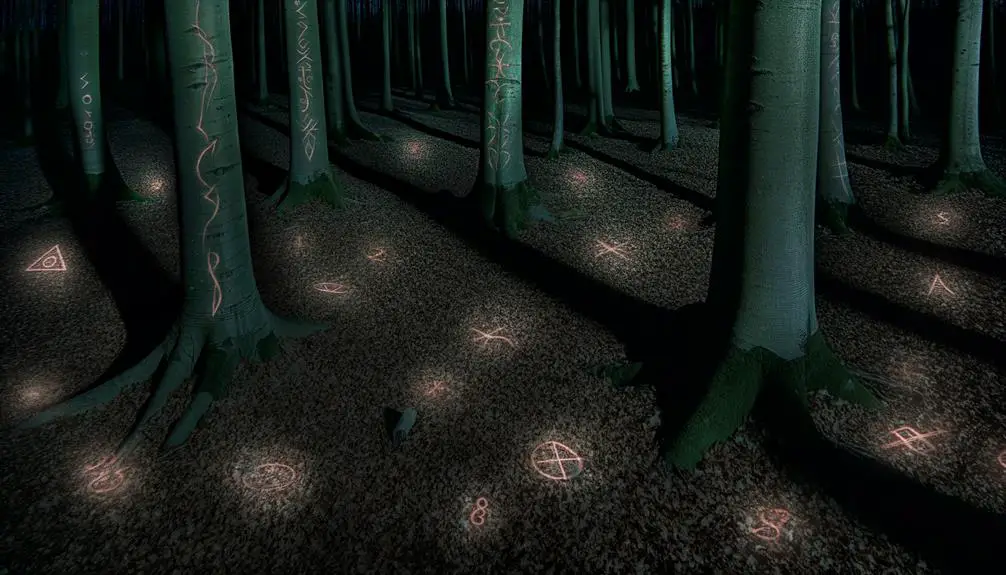
Occasionally found in the series, the hidden occult symbols serve as critical narrative devices that deepen the enigmatic atmosphere of 'Devil in Ohio.'
These symbols, often subtly integrated into the mise-en-scène, act as visual cues that enhance the thematic complexity. They are meticulously designed to evoke a sense of dread and curiosity, compelling viewers to explore further into the show's underlying mysteries.
The symbols' historical and cultural connotations are thoughtfully employed to create an immersive experience, bridging the gap between fiction and reality. By embedding these occult elements, the narrative fosters a rich interpretive space where audience members can investigate the darker aspects of human belief and fear.
Each symbol, though cryptic, is a deliberate choice that contributes to the overarching narrative.
The Devil's Mark
Central to the narrative of 'Devil in Ohio,' the Devil's Mark serves as a potent symbol that encapsulates the show's exploration of dark rituals and esoteric beliefs.
This emblem, often etched onto characters or artifacts, signifies a binding pact with malevolent forces. Its presence is not merely ornamental; it underscores the psychological and societal impacts of occult practices within the storyline.
The Devil's Mark functions as a narrative device that delves into themes of power, loyalty, and fear, providing a tangible representation of the characters' internal and external conflicts. By embedding this symbol within the plot, the show highlights the pervasive influence of hidden, sinister forces, compelling viewers to confront the unsettling realities of occult devotion.
Ancient Runes
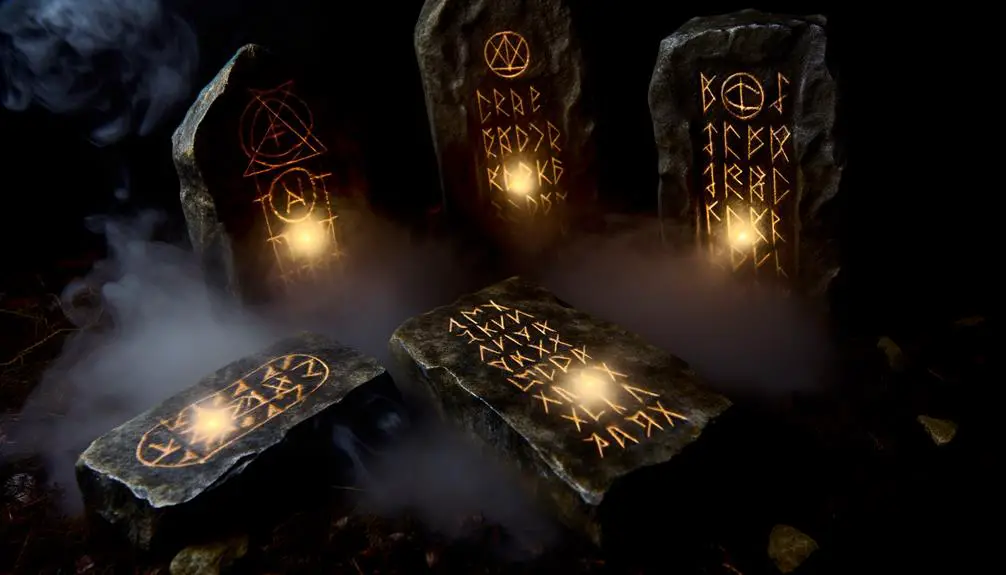
Ancient runes, frequently intertwined with the narrative of 'Devil in Ohio,' serve as cryptic keys that reveal deeper layers of the show's exploration of mystical and arcane traditions. These symbols, often derived from Norse or Anglo-Saxon origins, encapsulate a wealth of hidden meanings and are integral to the storyline's progression.
By embedding these runes into the plot, the series not only heightens its aura of mystery but also connects with historical practices of divination and magic. The runes' presence underscores themes of esoteric knowledge and power, compelling viewers to ponder the broader implications of these ancient scripts.
Their usage is not merely decorative but a deliberate choice to deepen the narrative's complexity and authenticity.
The Shadowy Figure
The shadowy figure in 'Devil in Ohio' serves as a pivotal narrative device, embodying the show's themes of fear, uncertainty, and the unknown. This enigmatic presence is not merely a character but symbolizes the pervasive sense of dread that engulfs the protagonists.
It acts as a visual metaphor for the hidden dangers lurking within the seemingly mundane, challenging viewers to question reality versus perception. The figure's obscured identity and eerie demeanor heighten the psychological tension, compelling the audience to confront their own anxieties.
Blood Rituals
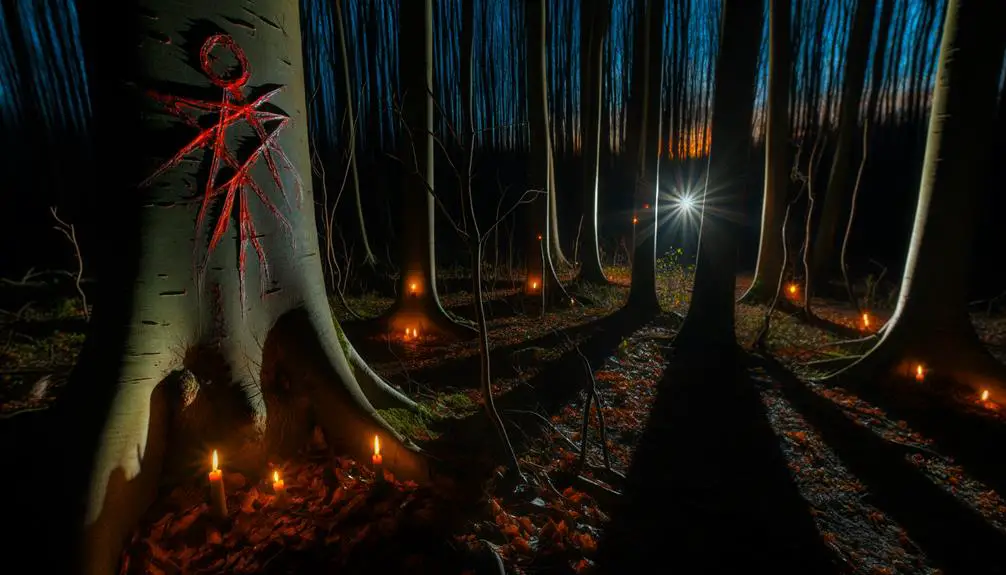
Blood rituals, often laden with ritualistic symbolism, have deep roots in various historical contexts, serving as potent expressions of devotion, power, and transformation.
Historical blood sacrifices can be traced back to ancient civilizations where they were employed to appease deities or seek favor.
Understanding these practices within 'Devil in Ohio' requires analyzing their symbolic significance and historical antecedents.
Ritualistic Symbolism Explained
Ritualistic symbolism in the context of blood rituals often serves as a powerful conduit for invoking spiritual or supernatural entities, reflecting deep-seated cultural and psychological significance.
Blood, seen as the essence of life, symbolizes vitality, sacrifice, and a connection to the divine or otherworldly. This symbolism is deeply embedded in various rituals, where the offering of blood is believed to appease deities or spirits, thereby ensuring protection, prosperity, or favor.
In many traditions, the use of blood in rituals underscores themes of life, death, and rebirth, creating a tangible link between the physical and spiritual domain.
Understanding these symbols requires a nuanced appreciation of the cultural and psychological underpinnings that inform these practices across different societies.
Historical Blood Sacrifices
Examining the historical context of blood sacrifices reveals a complex tapestry of beliefs and practices that have shaped various ancient civilizations. These rituals were often performed to appease deities, ensure bountiful harvests, or seek protection against adversities. Understanding the nuances of these ancient rites provides valuable insight into the cultural and religious frameworks of the time.
- Aztecs: Conducted human sacrifices to honor gods like Huitzilopochtli.
- Ancient Egyptians: Animal sacrifices were made to gods such as Ra and Osiris.
- Mesopotamians: Blood offerings were integral to appeasing deities like Marduk.
- Greeks and Romans: Sacrifices, often animal, were common in religious ceremonies.
- Celts: Practiced both animal and human sacrifices to divine spirits.
These practices illustrate the profound significance of blood rituals across different societies.
Symbolic Dreams
Symbolic dreams in 'Devil in Ohio' serve as a narrative device to explore the deeper psychological and emotional states of the characters. These dreams often mirror the internal conflicts, fears, and desires of the protagonists, providing insight into their subconscious minds.
For instance, recurring motifs such as dark forests or shadowy figures may symbolize unresolved trauma or impending danger. By integrating these dream sequences, the narrative allows for a richer, multi-dimensional understanding of character motivations and tensions.
This method effectively bridges the gap between the characters' overt actions and their internal experiences, thereby enhancing the thematic depth of the storyline. Through symbolic dreams, viewers gain access to the hidden layers of the plot, enriching their overall engagement with the series.
Conclusion
In summation, the symbols within 'Devil in Ohio' weave a complex tapestry of occult significance, from the potent pentagram to the enigmatic black rose.
These symbols, steeped in ancient mysticism and ritualistic power, serve as windows into a hidden world where every element holds meaning.
As the saying goes, 'The devil is in the details,' and in this case, each symbol meticulously contributes to the narrative's dark allure and profound mystery.

